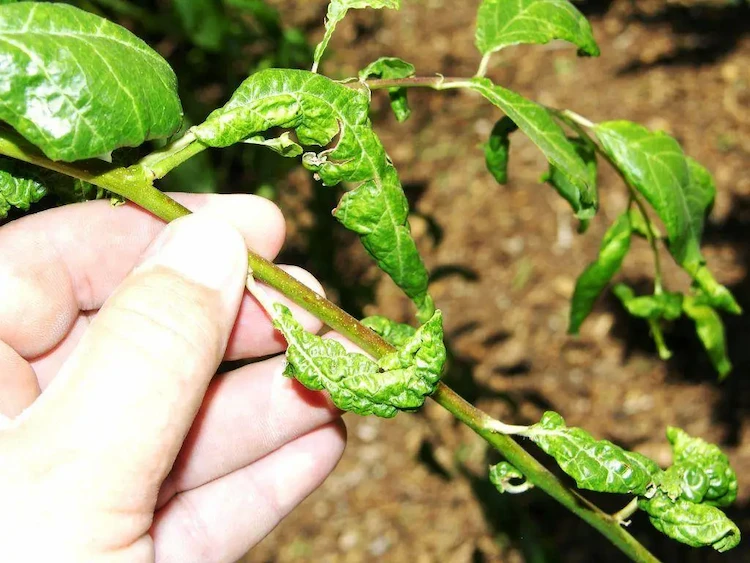Fruit trees are essential to any garden. Like all plants, fruit trees are subject to some diseases. Fruit tree leaves curl because of a fungal disease called Taphrina deformans. This is one of the most common fruit tree diseases affecting stone fruit such as peaches and nectarines. It is also called frizz disease. It causes the leaves to wrinkle and warp, and the leaves turn pink. There are other causes of curled leaves on fruit trees too and here we explain everything you need to know.
When does fruit tree leaf disease occur?
Leaf roll disease appears in spring, does the damage and then disappears. The fungus survives the winter as dormant spores on the branches. In the spring, as new growth begins, the leaves become infected.
What symptoms can occur?
When your fruit tree leaves curl up due to leaf curl, the trees have wrinkled, thickened and distorted leaves, often red in color. You will also spot a white bloom of fungal spores on the affected leaves. What happens to the leaves? Affected leaves fall off quickly, leading to defoliation and loss of vitality. Occasionally, shoots and fruits can also be affected.
Can you cure frizziness?
After the leaves on your fruit trees become infected, there are no methods of combating it. You need to examine your trees early so that you can prevent the disease. A locking spray can be applied before the buds develop.
How to prevent curled leaves?

It would seem logical to you to remove infected leaves from the tree in spring. However, this has not proven to be an effective solution. There are other preventive measures you can take to keep your fruit trees healthy. The most important protection against leaf curl is spraying the leaves with an organic agent at the right time. Only use biological sprays. This avoids damage to the trees and the environment.
For trees growing along a fence or wall, you can use a plastic sheeting rain shield to prevent infection. It should cover the top of the tree and the front to within a foot of the ground, with the ends open to allow access for pollinating insects. Put such a rain shelter after leaf fall in November and leave it until mid-May. This will help keep the sprouting shoots dry so infection can be prevented.
Fruit tree leaves curl: other causes
As mentioned earlier, there are other reasons why the leaves on your fruit trees are curling. The good news is that finding an antidote is much easier once you know the cause. Here we explain the main reasons for such problems and their solutions so that you can ensure that your fruit trees develop well.
Planting on a hot, sunny day or late in the season can cause fruit tree leaves to curl. Too much fertilizer builds up salts that can draw water from the roots and “burn” the leaves. Avoid fertilizers in the first season. Planting too shallow or too deep can also be problematic for the foliage. When planting trees, the holes should be wide but not too deep.
Aphid infestation can result in ruffled leaves

The most likely cause of curled leaves on fruit trees is aphids. It is worth noting that both black and green aphids can affect peach and nectarine trees. What to do? If you have curled leaves on your fruit trees, the first thing you should do is carefully examine the inside of the leaves. Even if you can’t see any insects, take a close look at some of the curled leaves. There you can discover aphids.
Problems with feeding the trees
Fruit tree leaves also curl up due to nutritional problems when the tree cannot absorb the nutrients it needs from the soil. In young trees, this may be due to the tree’s roots being damaged or drying out when planted. If your tree isn’t getting enough nutrients, you need to improve your soil. If you are growing citrus trees, be aware that they are heavy feeders and require more nutrients than many other fruit trees. This may mean using more compost or aged manure than your other trees.
Fruit tree leaves curl due to over and under watering
Yes, as with most plants, water plays a very important role in fruit trees. Underwatering (also known as water stress) is often manifested by ruffled leaves. Fruit tree leaves curl up, often lengthwise. This differs from the outward curl in the center of the leaf that is typical of feeding problems. Water stress is easily remedied by simply watering the tree more! Also, overwatering can cause some leaf problems, with leaves turning brown and crusty. Monitor soil moisture and make sure the site has good drainage so you don’t run into problems with your trees’ water needs! If you spot signs of waterlogging, you have a more difficult problem. Not only overwatering, but possibly water from a drainpipe can also cause the problem.